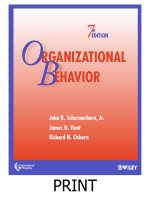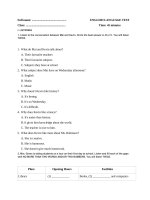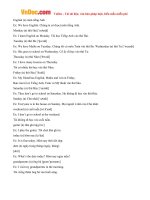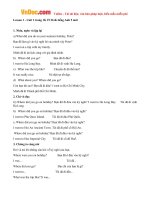Organizational behavior lecture notes, unit 3 OB
Bạn đang xem bản rút gọn của tài liệu. Xem và tải ngay bản đầy đủ của tài liệu tại đây (539.9 KB, 8 trang )
Lecture notes, unit 3 OB
Unit 3
Contrast terminal and instrumental values following are some examples of terminal values: a world of peace, a sense of
accomplishment, a world of beauty, equality, freedom, and salvation.
following are some examples of instrumental values: capable, cheerful, courageous,
imaginative, logical, loving, and responsible.
List the dominant values in today’s workforce
We will look at values of different age groups
Identify the five dimensions of national culture
We will look at how cultures and differ around the world
Contrast the three components of an attitude
•
•
•
Cognitive component
Affective component
Behavioral component
1
Some employee reactions are normal and good while others are not
The importance can be measured by the above
Values represent basic convictions that a “specific mode of conduct or end-state of
existence is personally or socially preferable to an opposite or converse mode of conduct
or end-state of existence.”
2
Values represent basic convictions that a “specific mode of conduct or end-state of
existence is personally or socially preferable to an opposite or converse mode of conduct
or end-state of existence.”
Milton Rokeach created the Rokeach Value Survey (RVS) which consists of two sets of
values: terminal values or desirable end-states of existence and instrumental values,
preferable modes of behavior or means of achieving the terminal values.
The following are some examples of terminal values: a world of peace, a sense of
accomplishment, a world of beauty, equality, freedom, and salvation.
The following are some examples of instrumental values: capable, cheerful, courageous,
imaginative, logical, loving, and responsible.
Several studies confirm that RVS values vary among groups. People in the same
occupations or categories, such as corporate executives, union members, or community
activists, tend to hold similar values. The variance in RVS values among such groups is
significant because they all have a vested interest in what corporations do.
What can you say about Vietnam?
Workers who grew up influenced by the Great Depression, World War II, U.S. leadership
in world manufacturing, the Andrews sisters, and the Berlin blockade entered the
workforce from the mid-1940s to the late 1950s. They believe in the Protestant work
ethic. Once hired, they tend to be loyal to an employer. They are likely to value family
security and a comfortable life.
Employees who entered the workforce from the 1960s to the mid-1970s were influenced
by John F. Kennedy, the civil rights movement, the Beatles, and the war in Vietnam. They
brought with them a large measure of the “hippie ethic” and existential philosophy.
Quality of life is more important to them than money and possessions. They value
autonomy, freedom, and equality.
Those who entered the workforce from the mid-1970s through the mid-1980s reflect
society’s return to more traditional values but with a greater emphasis on achievement
and material success. They were influenced by Ronald Reagan conservatism, the defense
build-up, dual-career households, and $150,000 starter homes. As pragmatists, they
believe that the ends can justify the means. A sense of accomplishment and social
recognition rank high for them.
The lives of the members of Generation X have been shaped by globalization, the fall of
Communism, MTV, AIDS, and computers. They value flexibility, life options, job
3
satisfaction, family, and relationships. Money is important as an indicator of career
performance, but they are less willing to trade off leisure time for increases in salary,
titles, security, and promotions.
One of the most widely referenced approaches for analyzing variations across cultures
was done by Geert Hofstede. After surveying 116,000 IBM workers in 40 countries, he
found that managers and employees differ on the following five value dimensions of
national culture:
Power distance. This is the degree to which people accept that power in institutions and
organizations is distributed unequally. The range is from relatively equal (low power
distance) to very unequal (high power distance).
Individualism is the degree to which people in a country prefer to act alone rather than as
members of groups. Collectivism is the equivalent of low individualism.
Quantity of life is the degree to which people value assertiveness, competition, and the
acquisition of money and possessions. Quality of life is the degree to which people value
relationships and show sensitivity and concern for others.
Uncertainty avoidance is the degree to which people prefer structured over unstructured
situations. People who score high on uncertainty avoidance have an increased level of
anxiety.
People in long-term orientation countries look to the future and value thrift and
persistence. A short-term orientation values the past and present and emphasizes respect
for tradition and social obligations.
Most of the concepts that make up the body of knowledge called organizational behavior
have been developed by Americans using subjects within domestic contexts. Therefore,
not all OB concepts and theories are universally applicable to managing in a global
context, especially in countries where work values are considerably different from those
4
in the United States. So cultural values should be considered when trying to understand
behavior.
Ask individuals to explain based on text and discuss
Compare with university student attitudes
Individuals seek consistency. Cognitive dissonance occurs when there are inconsistencies
between two or more of a person’s attitudes or between a person’s attitudes and
behaviors. The theory of cognitive dissonance suggests that people try to minimize
dissonance and the discomfort it causes.
Several moderating factors suggest that individuals who are experiencing dissonance will
not necessarily move directly toward a reduction of the dissonance (consistency). If the
5
elements creating the dissonance are relatively unimportant, the pressure to correct the
imbalance will be low. Also, the degree of influence that one has over the elements
involved will affect how he or she reacts to dissonance. Rewards also influence the
degree to which individuals are motivated to reduce dissonance.
Recent research has demonstrated that attitudes significantly predict future behavior and
that the attitude-behavior relationship can be enhanced by taking moderating variables
into account.
Three powerful moderators are the importance, specificity, and accessibility of the
attitude. In addition, the existence of social pressures and whether a person has direct
experience with the attitude are also strong moderators.
Modern theory, ask one team to explain
6
ask one team to explain
Employee dissatisfaction can be expressed in four types of responses which differ from
one another along two dimensions: constructive/destructive and active/passive.
1.
Exit. Behavior directed toward leaving the organization, such as looking for a
new position or resigning.
2.
Voice. Actively and constructively attempting to improve conditions, such as
suggesting improvements, discussing problems with superiors, and some forms of union
activity.
3.
Loyalty. Passively but optimistically waiting for conditions to improve, such as
speaking up for the organization in the face of external criticism and trusting the
organization and its management to “do the right thing.”
4.
Neglect. Passively allowing conditions to worsen, such as chronic lateness
or absenteeism, reduced effort, and increased error rate.
Fairness is critical
7
8









